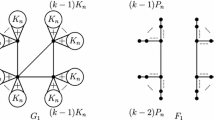Abstract
Let \({\mathcal{F}}\) be a family of graphs. A graph G is called \({\mathcal{F}}\)-free if for any \(F\in {\mathcal{F}}\), there is no subgraph of G isomorphic to F. Given a graph T and a family of graphs \({\mathcal{F}}\), the generalized Turán number of \({\mathcal{F}}\) is the maximum number of copies of T in an \({\mathcal{F}}\)-free graph on n vertices, denoted by \(ex(n,T,{\mathcal{F}})\). A linear forest is a graph whose connected components are all paths or isolated vertices. Let \({\mathcal{L}}_{n,k}\) be the family of all linear forests of order n with k edges and \(K^*_{s,t}\) be a graph obtained from \(K_{s,t}\) by substituting the part of size s with a clique of order s. In this paper, we determine the exact values of \(ex(n,K_s,{\mathcal{L}}_{n,k})\) and \(ex(n,K^*_{s,t},{\mathcal{L}}_{n,k})\). Also, we study the case of this problem when the “host graph” is bipartite. Denote by \(ex_{bip}(n,T,{\mathcal{F}})\) the maximum possible number of copies of T in an \({\mathcal{F}}\)-free bipartite graph with each part of size n. We determine the exact value of \(ex_{bip}(n,K_{s,t},{\mathcal{L}}_{n,k})\). Our proof is mainly based on the shifting method.
Similar content being viewed by others
References
Alon, N., Shikhelman, C.: Many \(T\) copies in \(H\)-free graphs. J. Combin. Theory Ser. B 121, 146–172 (2016)
Erdős, P., Gallai, T.: On maximal paths and circuits of graphs. Acta Math. Acad. Sci. Hung. 10, 337–356 (1959)
Füredi, Z., Simonovits, M.: The history of degenerate (bipartite) extremal graph problems. In: Lovász, L., Ruzsa, I.Z., Sós, V.T. (eds.) Erdős Centennial, Bolyai Society Mathematical Studies, vol. 25, p. 730. Springer, Berlin (2013)
Gerbner, D., Győri, E., Methuku, A., Vizer, M.: Generalized Turán numbers for even cycles. Acta Math. Univ. Comen. 88, 723–728 (2019)
Gerbner, D., Győri, E., Methuku, A., Vizer, M.: Generalized Turán problems for even cycles. J. Combin. Theory Ser. B 145, 169–213 (2020)
Gerbner, D., Methuku, A., Vizer, M.: Generalized Turán problems for disjoint copies of graphs. Discrete Math. 342, 3130–3141 (2019)
Gerbner, D., Palmer, C.: Counting copies of a fixed subgraph in \(F\)-free graphs. Eur. J. Combin. 82, 103001 (2019)
Gerbner, D., Palmer, C.: Some exact results for generalized Turán numbers. arXiv:2006.03756v1 (2020)
Gishboliner, L., Shapira, A.: A generalized Turán problem and its applications. Int. Math. Res. Not. IMRN 11, 3417–3452 (2020)
Győri, E., Li, H.: The maximum number of triangles in \(C_{2k+1}\)-free graph. Combin. Probab. Comput. 21, 187–191 (2012)
Kelmans, A.K.: On graphs with randomly deleted edges. Acta. Math. Acad. Sci. Hung. 37, 77–88 (1981)
Lan, Y., Shi, Y.: Palnar Turán numbers of short paths. Graphs Combin. 35(5), 1035–1049 (2019)
Lovász, L.: Combinatorial Problems and Exercises. Akadémiai Kiadó/North-Holland, Budapest (1979)
Luo, R.: The maximum number of cliques in graphs without long cycles. J. Combin. Theory Ser. B 128, 219–226 (2018)
Ma, J., Qiu, Y.: Some sharp results on the generalized Turán numbers. Eur. J. Combin. 84, 103026 (2020)
Ning, B., Peng, X.: Extensions of the Erdős–Gallai theorem and Luo’s theorem. Combin. Probab. Comput. 29, 128–136 (2020)
Ning, B., Wang, J.: The formula for Turán number of spanning linear forests. Discrete Math. 343, 111924 (2020)
Wang, J.: The shifting method and generalized Turán number of matchings. Eur. J. Combin. 85, 103057 (2020)
Zykov, A.A.: On some properties of linear complexes. Mat. Sb. 66, 163–188 (1949)
Acknowledgements
The authors would like to thank an anonymous referee for providing valuable comments and suggestions which improved the presentation of this paper.
Author information
Authors and Affiliations
Corresponding author
Ethics declarations
Conflict of interest
The authors declare that they have no conflict of interest.
Additional information
Publisher's Note
Springer Nature remains neutral with regard to jurisdictional claims in published maps and institutional affiliations.
Supported by the National Natural Science Foundation of China (No. 11871398) and the Seed Foundation of Innovation and Creation for Graduate Students in Northwestern Polytechnical University (No. CX2020190).
Rights and permissions
About this article
Cite this article
Zhang, LP., Wang, L. & Zhou, J. The Generalized Turán Number of Spanning Linear Forests. Graphs and Combinatorics 38, 40 (2022). https://doi.org/10.1007/s00373-021-02403-9
Received:
Revised:
Accepted:
Published:
DOI: https://doi.org/10.1007/s00373-021-02403-9



